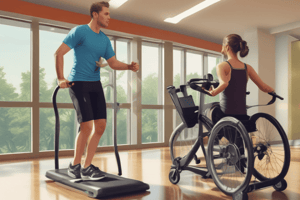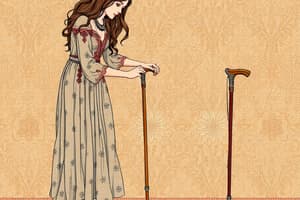Podcast
Questions and Answers
Which of the following is a learning outcome for Module 6 Mobility BHSC 1000 Class 1?
Which of the following is a learning outcome for Module 6 Mobility BHSC 1000 Class 1?
- Explain the concept of gas exchange
- Identify risk factors for impaired mobility in an older adult (correct)
- Describe the process of bone formation
- Discuss the impact of mobility on mental health
What is the scope of mobility as mentioned in the text?
What is the scope of mobility as mentioned in the text?
- Only gross simple movements
- Fine complex movements and coordination
- Gross simple movements and fine complex movements (correct)
- Limitation in physical movement and inability to move
How are the concepts of perfusion, mobility, and gas exchange connected?
How are the concepts of perfusion, mobility, and gas exchange connected?
- Perfusion facilitates venous return, improves circulation and strengthens cardiovascular health (correct)
- Perfusion supports aerobic respiration and sustained muscle activity
- Mobility delivers blood to the bones and muscles for nourishment and waste removal
- Gas exchange moves O2 and CO2 into and out of blood
What are the requirements for mobility as mentioned in the text?
What are the requirements for mobility as mentioned in the text?
Which of the following is a risk factor for impaired mobility in older adults?
Which of the following is a risk factor for impaired mobility in older adults?
Where does bone remodeling occur?
Where does bone remodeling occur?
What is osteoporosis characterized by?
What is osteoporosis characterized by?
What are non-modifiable risk factors for osteoporosis?
What are non-modifiable risk factors for osteoporosis?
What happens to bone resorption and formation after peak bone mass is achieved?
What happens to bone resorption and formation after peak bone mass is achieved?
How is blood calcium level maintained?
How is blood calcium level maintained?
What causes a significant decrease in bone mass in females?
What causes a significant decrease in bone mass in females?
What is the main pathogenesis of osteoporosis?
What is the main pathogenesis of osteoporosis?
When does clinical manifestation of osteoporosis occur?
When does clinical manifestation of osteoporosis occur?
How is bone mineral density assessed?
How is bone mineral density assessed?
What is the purpose of assessing bone mineral density?
What is the purpose of assessing bone mineral density?
What is the main cause of osteomalacia?
What is the main cause of osteomalacia?
Which of the following is considered a condition that might lead to partial mobility impairment?
Which of the following is considered a condition that might lead to partial mobility impairment?
What is the main factor affecting immobility in certain conditions that require rest and recovery?
What is the main factor affecting immobility in certain conditions that require rest and recovery?
Which of the following is a requirement for mobility as mentioned in the text?
Which of the following is a requirement for mobility as mentioned in the text?
What is the scope of full mobility as mentioned in the text?
What is the scope of full mobility as mentioned in the text?
Which cell type is responsible for bone resorption?
Which cell type is responsible for bone resorption?
What is the primary factor influencing peak bone mass?
What is the primary factor influencing peak bone mass?
What is the main regulator of calcium homeostasis?
What is the main regulator of calcium homeostasis?
Which bone tissue type is also known as trabecular bone?
Which bone tissue type is also known as trabecular bone?
What is the primary characteristic of osteoporosis?
What is the primary characteristic of osteoporosis?
Which hormone plays an essential role in bone growth and remodeling?
Which hormone plays an essential role in bone growth and remodeling?
What is the primary site for osteoporotic fractures?
What is the primary site for osteoporotic fractures?
Which factor is NOT a risk factor for osteoporosis?
Which factor is NOT a risk factor for osteoporosis?
What is the primary cause of age-related falls and fractures?
What is the primary cause of age-related falls and fractures?
Which bone tissue type is also known as cortical bone?
Which bone tissue type is also known as cortical bone?
What is the primary manifestation of osteoporosis?
What is the primary manifestation of osteoporosis?
Which factor significantly influences calcium homeostasis?
Which factor significantly influences calcium homeostasis?
What is the primary function of mobility?
What is the primary function of mobility?
Which factor can cause partial mobility impairment?
Which factor can cause partial mobility impairment?
What is the scope of full mobility as mentioned in the text?
What is the scope of full mobility as mentioned in the text?
How is immobility beneficial in certain conditions?
How is immobility beneficial in certain conditions?
Which of the following factors is critical for healthy aging?
Which of the following factors is critical for healthy aging?
Which hormone plays an essential role in bone growth and remodeling?
Which hormone plays an essential role in bone growth and remodeling?
What is the primary site for osteoporotic fractures?
What is the primary site for osteoporotic fractures?
What is the main regulator of calcium homeostasis?
What is the main regulator of calcium homeostasis?
What is the primary cause of age-related falls and fractures?
What is the primary cause of age-related falls and fractures?
What is osteoporosis characterized by?
What is osteoporosis characterized by?
What happens to bone resorption and formation after peak bone mass is achieved?
What happens to bone resorption and formation after peak bone mass is achieved?
What is the primary characteristic of osteoporosis pathogenesis?
What is the primary characteristic of osteoporosis pathogenesis?
What is the main factor influencing peak bone mass?
What is the main factor influencing peak bone mass?
What is the primary manifestation of osteoporosis?
What is the primary manifestation of osteoporosis?
What is the main factor affecting immobility in certain conditions that require rest and recovery?
What is the main factor affecting immobility in certain conditions that require rest and recovery?
What is the primary requirement for mobility as mentioned in the text?
What is the primary requirement for mobility as mentioned in the text?
Flashcards are hidden until you start studying
Study Notes
Aging and Osteoporosis: Risk Factors and Conditions
- Age-related changes can lead to falls, fractures, and loss of mobility
- Factors critical for healthy aging include bone strength, muscle strength, joint health, neurological function, and nutrition
- Bone tissue is composed of compact bone (cortical) and spongy bone (trabecular)
- Bone tissue cell types include osteogenic cells, osteoblasts, osteoclasts, and osteocytes
- Bone remodeling is a dynamic process crucial for maintaining, repairing, and adapting bone
- Osteoporosis is characterized by low bone density and increased risk of fracture
- Osteoporosis is more prevalent in women, with risk factors including age, low calcium or Vit D, genetics, hormone imbalance, race, and medications
- Peak bone mass is influenced by genetics, sex, puberty, and lifestyle factors
- Calcium homeostasis is regulated by parathyroid hormone and activated vitamin D
- Estrogens and androgens play essential roles in bone growth and remodeling
- Osteoporosis pathogenesis involves high turnover and remodeling imbalance, affecting both spongy and compact bone
- Clinical manifestations of osteoporosis include fractures, pain, deformity, and additional falls, with common fracture sites being the hip, distal radius, and vertebrae
Aging and Osteoporosis: Risk Factors and Conditions
- Age-related changes can lead to falls, fractures, and loss of mobility
- Factors critical for healthy aging include bone strength, muscle strength, joint health, neurological function, and nutrition
- Bone tissue is composed of compact bone (cortical) and spongy bone (trabecular)
- Bone tissue cell types include osteogenic cells, osteoblasts, osteoclasts, and osteocytes
- Bone remodeling is a dynamic process crucial for maintaining, repairing, and adapting bone
- Osteoporosis is characterized by low bone density and increased risk of fracture
- Osteoporosis is more prevalent in women, with risk factors including age, low calcium or Vit D, genetics, hormone imbalance, race, and medications
- Peak bone mass is influenced by genetics, sex, puberty, and lifestyle factors
- Calcium homeostasis is regulated by parathyroid hormone and activated vitamin D
- Estrogens and androgens play essential roles in bone growth and remodeling
- Osteoporosis pathogenesis involves high turnover and remodeling imbalance, affecting both spongy and compact bone
- Clinical manifestations of osteoporosis include fractures, pain, deformity, and additional falls, with common fracture sites being the hip, distal radius, and vertebrae
Studying That Suits You
Use AI to generate personalized quizzes and flashcards to suit your learning preferences.




